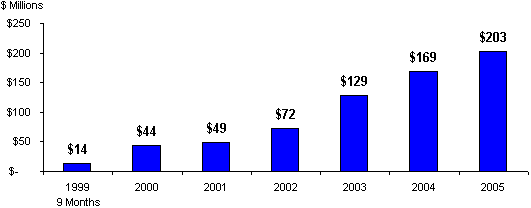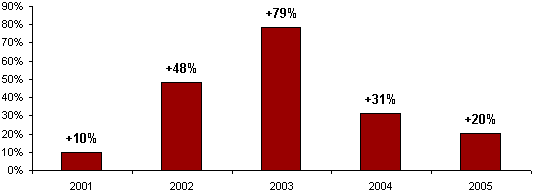IDEX Online Research: Blue Nile Sales & Profit Growth Moderates in Q4
February 16, 06
For its fourth quarter ended December 2005, Blue Nile, the leading online jewelry retailer in the U.S., reported weaker-than-expected sales gains. Profits were at the low end of expectations.
As a result, Wall Street reacted with its usual knee-jerk reaction, taking the stock from $37 per share to $30 overnight. The stock, though, is still trading at a very high valuation level of 49 times earnings at the current price of around $33 per share. It had traded as high as $44 per share, or nearly 60 times projected earnings, in 2005.
Are Blue Nile’s financials really deteriorating? IDEX Online examines the company’s key financial metrics below, and our conclusion is that the company is entering its next growth phase, a period when the torrid growth patterns that typically characterize a start-up begin to moderate as the company enters a period of maturing. We continue to believe that Blue Nile’s operating model is sound, and will fuel its long term growth. In addition, we believe that Blue Nile’s operating model will also have a far-reaching impact on the economic operating model traditionally utilized by store-based jewelers.
Putting Blue Nile’s Performance Into Perspective
Let’s put Blue Nile’s recent performance into perspective
- Blue Nile’s total fourth quarter sales were the equivalent of roughly 185 traditional store-based jewelers in the U.S. – Blue Nile’s total fourth quarter sales of $73.2 million represented the total fourth quarter sales of the equivalent of about 185 traditional store-based jewelers in the U.S. If we make this calculation based solely on diamond engagement sales, Blue Nile’s fourth quarter sales represent the equivalent diamond revenues generated by approximately 366 traditional stores in the fourth quarter. Finally, its fourth quarter sales gain – its year-over-year sales increase of $8.7 million – represented the equivalent diamond sales of roughly 43 traditional jewelry stores in the fourth quarter. Clearly, Blue Nile is a major factor in the jewelry industry, and it is taking market share from traditional jewelers.
- Blue Nile is now the 24th largest jeweler in the U.S. – Based on our estimates of both publicly held and privately owned jewelers in the U.S., Blue Nile’s total 2005 revenues of $203.2 million make them the 24th largest jewelry chain in the nation. Blue Nile has achieved this status after only six years of operation. It has an estimated 0.4 percent market share in the U.S.
- Blue Nile has about 3 percent market share of U.S. engagement ring sales – Based on our research which indicates that the U.S. engagement ring market size is about $4.8 billion, Blue Nile’s $144 million of engagement ring sales in 2005 represent 3 percent of the market.
What’s Happening At Blue Nile
Blue Nile posted solid financial results for both its fourth quarter and full year. In fact, most jewelers would probably like to have had their financial results.
Here are highlights of the company’s fourth quarter performance:
|
|
- Sales advanced – Total sales were up 13.5 percent in the three-month period ended December 2005. November sales were strong, but the first three weeks of December were below plan. The average ticket was $1,384; fourth quarter sales are heavily influenced by non-engagement business, which carries an inherently lower retail value. Engagement sales were 72 percent of corporate revenues, down modestly from 74 percent in the prior year. Blue Nile noted some softness in demand for big expensive stones. (See management comments near end of this article.) Blue Nile’s on-time shipping reached 99.87 percent in the fourth quarter, according to management.
- Gross margin rose – Blue Nile’s gross margin rose to 22.2 percent from the prior year’s 21.9 percent. This 30 basis point increase came from a shift in sales mix toward non-engagement jewelry (mostly gemstone and gold jewelry) which carries an inherently higher margin that engagement jewelry.
- Operating costs under pressure – As a result of softer-than-expected sales, Blue Nile’s operating cost ratio rose to 11.9 percent from the prior year’s 11.4 percent. Public company costs soared - $700,000 versus $380,000 in the prior year. Marketing costs increased due to much higher “click-thru” costs related to its search ad program.
- Pretax margin up – Despite expense pressure, Blue Nile’s fourth quarter pretax margin rose to 11.3 percent of sales versus the prior year’s 11.1 percent. In part, greater interest income helped boost pretax profits. Blue Nile earned income on cash invested from proceeds of its initial public offering. After-tax profits rose 15.9 percent in the fourth quarter.
For the year, financial statistics were very impressive:
|
|
- Sales rose solidly – For the full twelve months ended December 2005, Blue Nile’s sales rose 20.0 percent versus the full year 2004.
- Gross margin flat – Blue Nile’s gross margin in both years was 22.2 percent for the twelve-month period.
- Operating expense ratio down – Blue Nile’s operating expense ratio (operating costs as a percentage of sales) was 13.3 percent in 2005, down from 13.5 percent in 2004. This decline came despite a sharp rise in public company expenses and costs associated with growth. Public company costs for the year were $2.6 million.
- Pretax margin up solidly – Blue Nile reported that its pretax margin was 10.1 percent for the full year 2005, up from the prior year’s 9.2 percent. After-tax profits were up a dramatic 31.7 percent.
- Blue Nile’s balance sheet is very strong – Blue Nile is awash in cash; it has no long term debt; and, management is repurchasing stock. Its inventory turns were 13.4 times in 2005, up modestly from 13.3 times in 2004. This inventory turn rate is multiples above typical store-based jewelers who turn their inventory about once a year. A high inventory turn helps Blue Nile conserve capital.
Blue Nile management reported the following business trends, some of which helped (and some of which hurt) overall annual results:
- Blue Nile’s average ticket was $1,450 for 2005 – For the full year ended December 2005, Blue Nile’s average ticket was about $1,450, nearly five times as large as the industry average ticket of $300. Clearly, Blue Nile’s average ticket is the result of selling high value diamonds, especially engagement rings. In the prior year, Blue Nile’s average ticket was about $1,360.
- Blue Nile’s average ticket for an engagement ring was a dramatic $5,700 – Blue Nile’s average ticket for an engagement ring in 2005 was about $5,700, more than double the typical U.S. engagement ring retail price of about $2,600 or $2,700. In 2004, its average ticket for an engagement ring was $5,600.
| Sales Mix
|
- Blue Nile engagement ring sales dominate its business – During 2005, engagement rings represented about 71 percent of total sales, dramatically above a typical U.S. jeweler’s engagement ring sales which are about 8-9 percent of sales. The table at right summarizes Blue Nile’s product mix. In 2004, Blue Nile’s engagement jewelry mix was 73 percent of sales.
- Blue Nile spent an estimated $45 per transaction to attract and complete each sale – This was dramatically below the typical $78 per transaction (source: IDEX Online Research) that it costs a store-based jeweler to attract and complete each sale. With lower marketing expenses, it is clear that Blue Nile has a cost advantage over store-based jewelers, in our opinion.
Blue Nile’s economic business model will force the jewelry industry to make changes in how it operates.
- Blue Nile relies heavily on memo goods – Blue Nile turned its inventory 13.4 times in 2005, dramatically above the abysmal 1.0 times turn typical of store-based jewelers. Blue Nile’s inventory turn is high because it refuses to own most of its inventory. Store-based jewelers, by contrast, own far too much inventory, which results in a costly capital-intensive business. Further, too many U.S. jewelers “fall in love” with the jewelry they buy, rather than buying what the consumer demands. Thus, jewelers hang onto obsolete jewelry far longer than be justified by any sane economic operating model. Blue Nile has successfully shifted most of its inventory capital needs to its vendors, a lesson store-based jewelers must learn.
- Blue Nile operates with very low gross margins – Does Blue Nile sell jewelry for less? Absolutely. A typical jeweler generates a gross margin of 49 percent, according to Jewelers of America and public company reports. Blue Nile’s gross margin is 22 percent. Thus, a ring with a $500 wholesale cost will sell for near $1,000 at a store-based jeweler while it will sell for a much more modest $645 at Blue Nile to yield a 22 percent gross margin.
- Blue Nile has very low operating costs – At 13.3 percent of sales, Blue Nile’s operating costs, as a percentage of sales, are about 1/3 of the typical jeweler’s operating costs (Zale’s were 41 percent of sales for its fiscal year ended July 2005).
Outlook: Blue Nile’s Sales Gains Should Moderate
Why should Blue Nile’s sales increases moderate? The quick answer is this: it is a function of the math. Volatile, unpredictable sales gains, which are characteristic of start-up operations, typically give way to more predictable, consistent sales trends which usually characterize a more mature company.
The following graphs illustrate sales trends for Blue Nile.
| Blue Nile Sales |
| Blue Nile Sales - % Change Year-to-Year |
Quotes & Comments from Blue Nile’s Conference Call
The following are snippets from Blue Nile’s year-end conference call.
- Management quote: “Over time, Blue Nile will need to have more fashion merchandise so repeat buyers will see something new.”
- Repeat and referral sales were very strong. Repeat and referral customers represent about 50 percent of Blue Nile’s business.
- Blue Nile’s goal is to monotize customer experiences. In other words, once a consumer clicks on Blue Nile’s site, the company’s goal is to sell them something.
- At some point in the near future, Blue Nile will send customized e-mails to reflect what you’ve bought in the past. The company will evaluate your price points, merchandise selection, and other factors (including timing – perhaps it can pinpoint your wedding anniversary date based on past purchase patterns). It will try to guess what you, as a customer, are looking for. Blue Nile will compose a unique e-mail directed to a single customer. In other words, Blue Nile will present a store front tailored to each individual customer.
- Blue Nile’s three strategic focuses for 2006 include the following:
- Expand core U.S. engagement / bridal business
- Expand non-engagement business
- Grow its international businesses in Canada and the U.K. Blue Nile’s value proposition is particularly compelling in the U.K. where there is less discounting.
- As a result of soaring click-through ad costs, Blue Nile will broaden its marketing program to include a variety of promotional vehicles, including perhaps some off-line advertising on radio, for example.
- Blue Nile will begin paying cash income taxes in the second quarter of this year, when its net operating losses (NOLs) run out.
- Management cited one example of sharply rising diamond jewelry prices. It said that a high quality two-carat diamond ring which sold for roughly $40,000 two years ago would sell for at least $60,000 to $70,000 today. Thus, management contends, many customers may be priced out of the market for high quality diamonds.
- Management’s goal is to build a $1 billion business. That would represent about 1 percent of the U.S. jewelry market, and make Blue Nile the 8th or 9th largest jeweler in the nation.
There has been virtually no fall-out from the GIA grading scandal. Management has tallied inbound calls: a total of eight customers have had questions about it. According to Blue Nile management, its customers simply are not aware of GIA’s problems.

